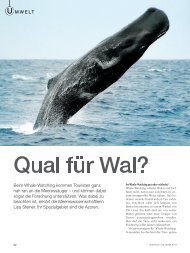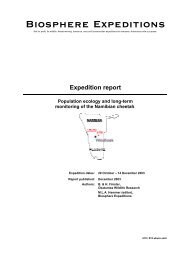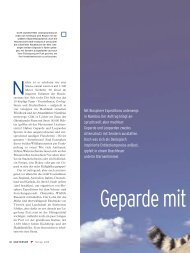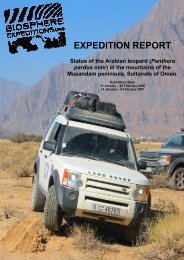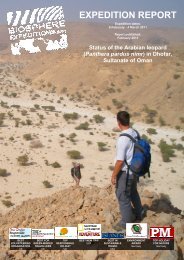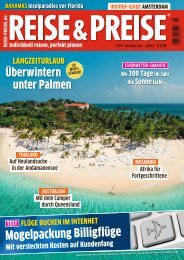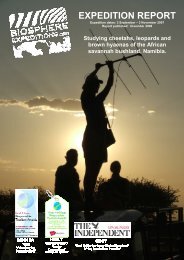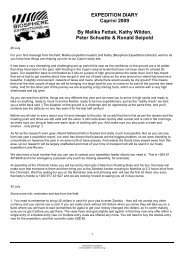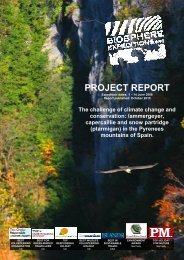EXPEDITION REPORT - Biosphere Expeditions
EXPEDITION REPORT - Biosphere Expeditions
EXPEDITION REPORT - Biosphere Expeditions
You also want an ePaper? Increase the reach of your titles
YUMPU automatically turns print PDFs into web optimized ePapers that Google loves.
Surveys were carried out during the winter period, in January/February 2009 and 2010.<br />
The survey area was sub-divided into three zones shown in Fig 2.2b within which survey<br />
routes covered as much of the area as time and terrain allowed. Surveys were conducted<br />
on foot, but many survey areas were accessed by vehicle (LR3s generously provided by<br />
Land Rover). The reconnaissance visit of Wadi Aydam in the Mudayy area in 2009<br />
involved vehicle as well as foot surveys. All surveys were designed to cover the best<br />
potential wildlife habitats and maximise chances of finding sign of leopard and prey<br />
species. Surveys were conducted by international and Omani field scientists, the<br />
expedition leader and international volunteers (team members).<br />
Training<br />
Team members were taught how to use GPS, map and compass. They received training<br />
in survey methodology, animal identification, habitat categories and Dhofar vegetation<br />
classification types. Volunteers were shown how to use binoculars for observing prey<br />
species and shown how to record information on the different datasheets to ensure they<br />
had the required GPS, compass and map-reading skills, and understood wildlife/wildlife<br />
sign identification, recording and collection protocol for surveys.<br />
Research activities<br />
Team members were trained to carry out leopard surveys, learning where to look for<br />
leopard sign and how to identify scats, scapes, urine, scent marks and claw rakes.<br />
Training included recording leopard signs and how to use the map and compass to take<br />
bearings of wildlife sightings and topographical landmarks. Having a large team to help<br />
survey helped cover a substantial geographical area in a relatively short time. It also<br />
meant that chances of finding sign of Arabian leopard and other wildlife were maximized<br />
by having many people fully engaged in looking for any possible sign.<br />
Collecting Arabian Leopard faecal samples was a high priority as a non-invasive<br />
technique. Genetic analysis based on faecal samples are increasingly being used to<br />
estimate abundance, identify behavioural parameters and understand population structure<br />
in species that are rare, threatened or cryptic (Piggot & Taylor 2003). Team members<br />
were shown how to collect and store faecal samples with minimum risk of contamination.<br />
However, abundance is a particularly difficult parameter to estimate for low-density, wideranging,<br />
elusive species, most of which are threatened (Schipper et al. 2008). Scat<br />
analysis is also used to determine Arabian Leopard diet, so samples were collected for<br />
future analysis.<br />
Team members were taught to survey wild ungulate prey species (Arabian gazelle and<br />
Nubian ibex) and hyrax colonies, and how to record topography and vegetation cover.<br />
Surveys involved recognising animals and their signs (tracks, faeces, resting/feeding<br />
areas). Observations were made using binoculars to count numbers and age/sex of<br />
individuals (ungulates only) and to observe behaviour.<br />
Camera-trapping, increasingly used as a survey tool, has been used in Dhofar for over 20<br />
years to record the presence of leopards and identify individuals. The sex and identity of<br />
leopards can be ascertained by the presence/absence of testes and each leopard’s unique<br />
coat pattern.<br />
16<br />
© <strong>Biosphere</strong> <strong>Expeditions</strong><br />
www.biosphere-expeditions.org



